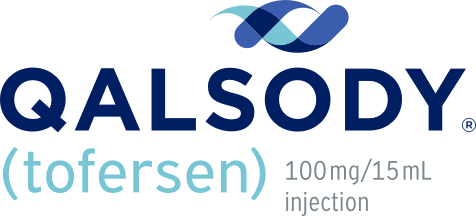VALOR/VALOR OLE results
VALOR results
Though VALOR did not achieve its primary endpoint at 28 weeks, biomarker results showed reductions in mean CSF SOD1 and plasma NfL levels with QALSODY vs placebo1
PRIMARY ENDPOINT:
mITT population (n=60)
Patients treated with QALSODY experienced less decline from baseline in the ALSFRS-R compared to placebo, but the results were not statistically significant.1
(QALSODY-placebo adjusted mean difference [95% CI]: 1.2 [-3.2, 5.5])
Other clinical secondary outcomes also did not reach statistical significance.
BIOMARKER ANALYSIS:
ITT population (N=108)
Plasma NfL declined until approximately Day 113, after which the reductions were sustained. The reductions in phosphorylated neurofilament heavy chain were similar compared to reductions in NfL, as were reductions in CSF compared to plasma.
Cardiac electrophysiology: At the maximum approved recommended dosing regimen, QALSODY does not prolong the QTc interval to any clinically relevant extent.
Total CSF SOD1 is an indirect measure of target engagement
Plasma NfL is a blood-based biomarker of axonal injury and neurodegeneration
ALSFRS-R=Amyotrophic Lateral Sclerosis Functional Rating Scale–Revised; CI=confidence interval; CSF=cerebrospinal fluid; NfL=neurofilament light chain; QTc=corrected QT.
Continued approval for this indication may be contingent upon verification of clinical benefit in confirmatory trial(s).
Plasma NfL declined until approximately Day 113, after which the reductions were sustained1
Week 28 mean plasma NfL in ITT population
(geometric mean ratio to baseline)1
Reduced 55% with QALSODY
Increased 12% with placebo
Difference in geometric mean ratios for QALSODY to placebo: 60%
ITT=intent-to-treat; LS=least squares.
VALOR OLE results
In the 52-week interim VALOR OLE exploratory analysis:
Earlier initiation of QALSODY compared to placebo/delayed initiation of QALSODY was associated with trends across multiple measures (not statistically significant)1
Earlier initiation of QALSODY compared to placebo/delayed initiation of QALSODY was associated with reductions in:
These exploratory analyses should be interpreted with caution given the limitations of data
collected outside of a controlled study, which may be subject to confounding.
The reductions in NfL seen in the placebo/delayed treatment arm at 52 weeks
were similar to those seen with earlier initiation of QALSODY
*The handheld dynamometry megascore is the average of z scores across 16 muscle groups in the arms and legs, with higher values indicating greater strength.2
OLE=open-label extension; SVC=slow vital capacity.
QALSODY clinical study milestones
QALSODY is indicated for the treatment of amyotrophic lateral sclerosis (ALS) in adults who have a mutation in the superoxide dismutase 1 (SOD1) gene. This indication is approved under accelerated approval based on reduction in plasma neurofilament light chain (NfL) observed in patients treated with QALSODY. Continued approval for this indication may be contingent upon verification of clinical benefit in confirmatory trial(s).
| VALOR (placebo-controlled) | WEEK 8 | |
|---|---|---|
QALSODY reduced total CSF SOD1 (an indirect measure of target engagement)1,2:35% reduction (geometric mean ratio to baseline) in the QALSODY arm compared to 2% reduction in the placebo arm at Week 28 in the ITT population. Difference in geometric mean ratios for QALSODY to placebo: 34% |
||
| VALOR (placebo-controlled) | WEEK 16 | |
|---|---|---|
QALSODY reduced mean plasma NfL (a blood-based biomarker of axonal injury and neurodegeneration)1,2:55% reduction (geometric mean ratio to baseline) in the QALSODY arm compared to 12% increase in the placebo arm at Week 28 in the ITT population. Difference in geometric mean ratios for QALSODY to placebo: 60% |
||
| VALOR (placebo-controlled) | WEEK 28 | |
|---|---|---|
Patients treated with QALSODY experienced less decline from baseline in the ALSFRS-R compared to placebo, but the results were not statistically significant (QALSODY-placebo adjusted mean difference [95% CI]: 1.2 [-3.2, 5.5]). Other clinical secondary outcomes also did not reach statistical significance.1 |
||
| OLE (open-label extension) | WEEK 52 | |
|---|---|---|
Reductions in NfL were seen in patients previously receiving placebo who initiated QALSODY in the OLE interim analysis, similar to the reductions seen in patients treated with QALSODY in VALOR.1 Through all the open-label follow-up at the time of the interim analysis, earlier initiation of QALSODY compared to placebo/delayed initiation was associated with trends for reduction in decline on ALSFRS-R, SVC percent-predicted, and HHD megascore that were not statistically significant. Earlier initiation of QALSODY was also associated with a trend towards reduction of the risk of death or permanent ventilation, although not statistically significant.1OLE exploratory analyses should be interpreted with caution given the limitations of data collected outside of a controlled study, which may be subject to confounding. |
||
